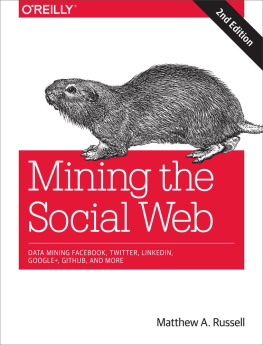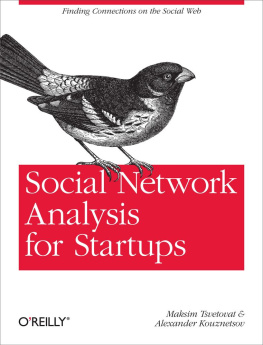Copyright
Acquiring Editor: Steve Elliot
Editorial Project Manager: Lindsay Lawrence
Project Manager: Punithavathy Govindaradjane
Designer: Mark Rogers
Morgan Kaufmann is an imprint of Elsevier
225 Wyman Street, Waltham, MA 02451, USA
Copyright 2013 Elsevier Inc. All rights reserved
No part of this publication may be reproduced or transmitted in any form or by any means, electronic or mechanical, including photocopying, recording, or any information storage and retrieval system, without permission in writing from the publisher. Details on how to seek permission, further information about the Publishers permissions policies and our arrangements with organizations such as the Copyright Clearance Center and the Copyright Licensing Agency, can be found at our website: www.elsevier.com/permissions.
This book and the individual contributions contained in it are protected under copyright by the Publisher (other than as may be noted herein).
Notices
Knowledge and best practice in this field are constantly changing. As new research and experience broaden our understanding, changes in research methods or professional practices, may become necessary. Practitioners and researchers must always rely on their own experience and knowledge in evaluating and using any information or methods described herein. In using such information or methods they should be mindful of their own safety and the safety of others, including parties for whom they have a professional responsibility.
To the fullest extent of the law, neither the Publisher nor the authors, contributors, or editors, assume any liability for any injury and/or damage to persons or property as a matter of products liability, negligence or otherwise, or from any use or operation of any methods, products, instructions, or ideas contained in the material herein.
Library of Congress Cataloging-in-Publication Data
Golbeck, Jennifer.
Analyzing the social web/Jennifer Golbeck.First edition.
pages cm.
Includes bibliographical references and index.
ISBN 978-0-12-405531-5 (alk. paper)
1.Social media. 2.Social networks. 3.Human-computer interaction. I. Title.
HM742.G65 2013
302.3dc23
2012049046
British Library Cataloguing-in-Publication Data
A catalogue record for this book is available from the British Library
ISBN: 978-0-12-405531-5
Printed and bound in the United States of America
13 14 15 16 1710 9 8 7 6 5 4 3 2 1

For information on all MK publications visit our website at www.mkp.com
Dedication
To Ingo
List of Figures
| Number | Figure |
| A sample social network. |
| The Gephi interface. |
| The NodeXL interface. |
| The five co-stars of Apollo 13. Each is represented as a node in the network. |
| The edges connect actors who were in movies together. |
| A labeled graph where the edges indicate at least one movie that the actors have been in together, not including Apollo 13. |
| A weighted graph where weights are indicated both as numbers and by the thickness of the edge. In this graph, weight indicates how many movies the actors have been in together. |
| Two ways of drawing a directed network. The edge from A to B is directed only one way. The edge from A to C goes in both directions and can be drawn either as one edge with two arrow heads (left) or as two edges pointing in opposite directions (right). |
| A social network with a singleton, dyad, and triad. |
| A sample undirected network. |
| (a) The 1-degree egocentric network of D, (b) the 1.5-degree egocentric network of D, (c) the 1.5 egocentric network of D with D excluded, and (d) the 2-degree egocentric network of D. |
| A sample undirected network. |
| A sample directed graph. |
| The node at the center of the cluster in the upper right would have a high degree centrality, even though it is far from the dense center of the network. |
| A sample network. |
| The degree distribution for the graph shown in . |
| Network (a) on the left has fewer edges than network (b) on the right. Since they both have the same number of nodes and thus the same number of possible edges, network (b) is more dense. |
| The 1.5-diameter egocentric networks for nodes A (a) and B (b) from . |
| A sample network with a connectivity of 2. |
| A regular graph. Each node is connected to the neighbor directly next to it and two steps away in the layout. |
| A random graph, with the same number of nodes and edges as the regular graph shown in . |
| (a) shows the stages of a regular graph becoming more random by removing and randomly reconnecting some of the edges. (b) shows how the clustering (C) remains high while the average shortest path length (L) quickly drops to low values as the graph becomes more random. The variable p indicates the probability of random edge rewiring. |
| Without conscious analysis, it is easy to pick out the circle as an anomaly in the pattern. |
| A single outlier point at value 2 on the x-axis is easy to see separated from the pattern of values. |
| A sample network visualization. |
| A random layout of the graph shown in . |
| A circular graph layout for the same graph shown in . |
| A grid layout of the modes in the sample graph. |
| A layout of the sample network using the Force Atlas algorithm. |
| The graph laid out with the Harel-Koren Fast multiscale algorithm. |
| A layout that groups clusters into boxes, sized by the size of the cluster, and shows links between boxes. |
| A network of YouTube videos with the node labels shown. |
| Color-coding nodes according to their degree, with higher degree shown by darker nodes. |
| A graph indicating clustering coefficient with node size and degree with node color. |
| The sample network with edge width indicating the weight on each edge. Note that the central node has medium-strength relationships with most neighbors, but weak ones to the cluster in the upper right and the chain in the lower right. The chain of nodes in the lower right have high weights on the edges connecting them. |
| A network of YouTube videos where color indicates the community or cluster to which each node belongs. |
| A network with 11,000 nodes and 40,000 edges. |
| A network of senators (nodes) with edges connecting senators who have voted the same way at least 40% of the time. The network is very dense, so it is not possible to see any interesting patterns. |
| The same network of senators as shown in , now filtered to include only edges between senators who have voted the same way on at least two-thirds of bills. |












